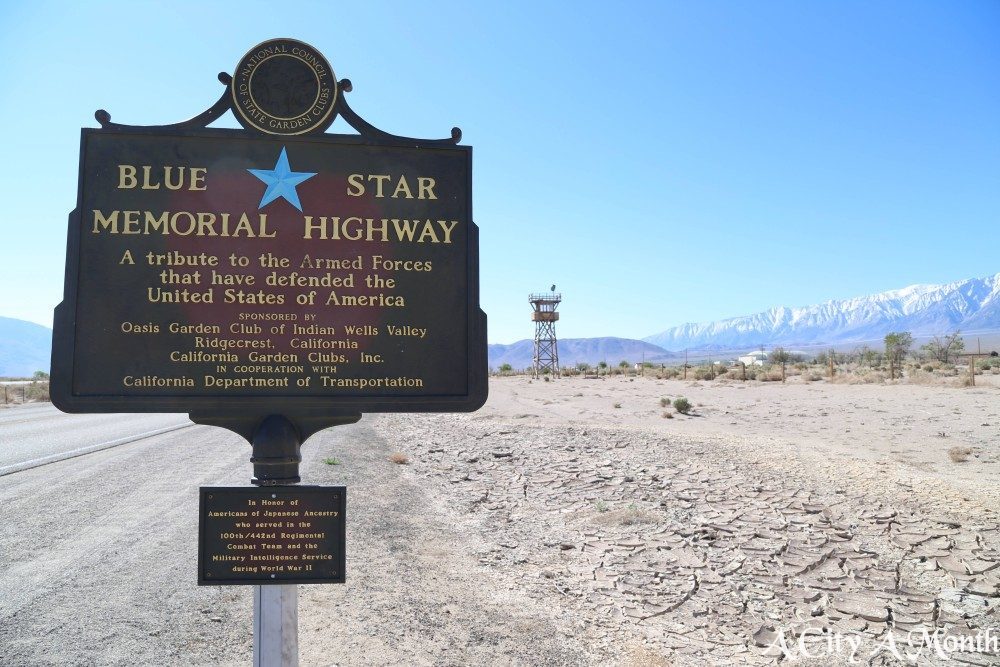Manzanar National Historic Site is both crime scene and memorial. Incarcerating more than 10,000 loyal Japanese Americans there as a result of hysteria and paranoia at the outbreak of World War II is a case study in how the ugly stain of racism continues to be a blot on the ideals of the American experiment.

The guard tower in the center was one of a number that ringed Manzanar designed to keep the detainees from escape.
But more recently, thanks to time, determination, and a willingness to acknowledge the sins of the past, Manzanar National Historic Site is evolving into a place to help us appreciate that, despite our differences, different cultures have more in common with each other than one might think, and that a nation can strive for a higher ideal.
Today, the gross injustice of rounding up as many as 120,000 Japanese Americans, turning them out of their homes, seizing their businesses and forcing them into one of 10 squalid and hastily-built detention centers is painfully obvious. Back then, petty jealousies and events were whipped into frenzy against Japanese Americans.

Flags from the other forced detention locations across the U.S. at the interpretive center at Manzanar.
Opponents and supporters quickly lined up. President Franklin D. Roosevelt signed Executive Order 9066 and Earl Warren, as attorney general of California, became a moving force there to ensure orders were followed. But J. Edgar Hoover, director of the Federal Bureau of Investigation, opposed the idea and labeled it as overreaction.

Flimsy and crude, the mess halls and barracks were terrible to look at and no doubt even worse to live in.
By World War II, Owens Valley, about 200 miles north of Los Angeles, had become a dust bowl. William Mulholland, the director of what became the Los Angeles Department of Water and Power, deceitfully acquired virtually all the water rights in Owens Valley. But a remote, dry, wind-swept valley was an ideal location to carve out 6,200 acres and incarcerate 10,000 Japanese Americans.
Manzanar was the largest of 10 incarceration centers scattered across seven states. Thousands of Japanese Americans – entire families – were packed off with little more than a few clothes and possessions they could carry. Their new homes were wooden barracks.

All meals were eaten in the mess halls, simple and drab, just like the barracks they lived and slept in.
The barracks were crude, drafty and offered virtually no privacy. Winter temperatures below freezing and summer highs above 100 degrees Fahrenheit were aggravated by wind that regularly blew through Owens Valley. And thanks to Mulholland’s earlier water grab, the wind carried and deposited alkali dust that passed through poorly built walls and the knotholes in the boards. Toilet and bathing facilities were located in other buildings and meals were served in communal mess halls.

Barracks housing the 10,000-plus men, women and children confined at Manzanar provided little shelter from the wind, winter cold and summer heat.
Despite illegal detention, losing everything and being humiliated, those forced to live at Manzanar and the other incarceration centers cobbled together some semblance of a life. They built schools for their children, health clinics and other facilities. They developed gardens and parks, play areas and ball fields. And they reserved a special place to honor and bury those who died there.
To give visitors a better sense of what Manzanar was like, some areas are slowly being restored and the story of that time is being told honestly and with a clear eye.
Throughout history, cruelty is a streak that shows itself far too often. Manzanar is one example of that. But a willingness to admit to a dark chapter of our past shows hope for a nobler aspect of America’s character in the future.
For more information about Manzanar refer to: www.nps.gov/manz/index.htm or www.manzanarcommittee.org





